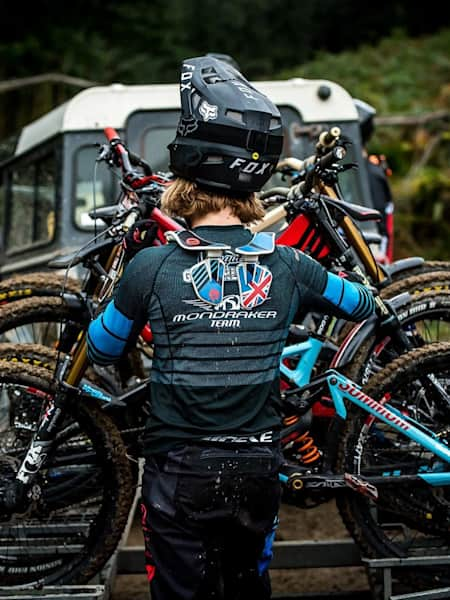Buying your first mountain bike can be a daunting experience; they’re not cheap and you’ll have plenty of other riders giving you information on why a certain type of bike is the absolute best. And we suspect that's usually the type of bike they ride...
Well, here we’re going to boil it down to the basics and give you a clear view of the four most common types of bikes you’ll find on the trail – downhill (DH), enduro, trail and cross-country (XC). Which one’s best for you? Only you can decide.
Make sure you hover over/tap on the images to get the key info.
Downhill bikes
What are DH bikes good for?
Downhill bikes are designed for going incredibly fast down hills, so for just about anything else, be it climbing, singletrack, or just pedalling about with your mates, they’re not so great.
What do they look like?
You can spot a downhill bike quite easily; it'll have lots of suspension travel, 200mm front and rear (called a full suspension bike), a tough-looking frame, long wheelbase and the geometry will have slacker angles (angled closer to the ground), with headtubes usually around the 62-64º mark. These angles ensure the bike is super-stable at high speeds and on steep pitches, but make it terrible for slower/flatter riding and climbing. It'll also have huge disc brake rotors and strong brakes, to help with stopping power when you’re on the ragged edge.
As they need to handle higher speeds and bigger hits, downhill bikes are usually quite heavy; so most riders will push up the climbs before riding. Lots of trail centres have dedicated uplift days where you can catch a lift to the top of the downhill runs, usually in a van with a trailer, helping to maximise your ride time.
Should you buy a DH bike?
Is a downhill bike a great first bike? Probably not – they’re incredibly good at doing one thing really well and only seem to come into their own when ridden seriously fast. But if you’re absolutely all about the downs and nothing else, then who are we to stop you?
Enduro bike
What are Enduro bikes good for?
Enduro bikes are the newest category of mountain bike on our list, being designed for the increasingly popular discipline of enduro racing. This is where rides are timed on a series of short(ish) technical runs, with untimed, often climbing sections between them.
With that in mind, enduro bikes need to be able to handle seriously gnarly terrain, while still being able to pedal efficiently between stages. They should also be strong enough to help deal with long days out on the trail.
What do they look like?
Suspension can range from 150-170mm front and rear, with 27.5-inch wheel sizes still being most common. However, like every other discipline in mountain biking, it seems 29ers are catching up.
Geometry is wide ranging, but usually sits somewhere between a trail bike and a downhill bike, meaning slacker angles, but still with an eye towards pedalling efficiency. Enduro riders tend to favour wider bars, shorter stems and tough tyres, which all contribute towards more control and reliability.
Should you buy an enduro bike?
Well if you’re dead set on racing enduro then yes. However, just like downhill bikes they can be quite expensive and need to be ridden hard to get the best out of them, so a trail bike is perhaps also worth considering when starting out. That being said, in the right hands, enduro bikes can be a whole lot of fun, so just remember to think carefully about the riding you’ll be doing before parting with your hard-earned cash.
You might also be interested to know that Sam Hill raced his enduro bike at this year's Downhill World Champs and finished in sixth. Although that could be because he's one of the best mountain bike racers in the world...
Trail bike
What are trail bikes good for?
Trail bikes are perhaps the largest, most ubiquitous category of mountain bike, but can often blur the lines into other categories – you might find a trail bike which leans towards XC, or one which has some downhill credentials. The point being that trail bikes are a jack of all trades and a master of none.
What do they look like?
Trail bikes will nearly always have full suspension and, depending on your budget, can be made from steel, aluminium, titanium or carbon fibre. The geometry can vary, but we’d class it as great for descending, whilst still being able to climb and hit the singletrack hard. The fact is, in the right hands, a trail bike can do fairly well almost anywhere, bar the absolute extremes of the mountain biking spectrum.
Suspension is once again wide ranging; 110-140mm rear and 120-150mm front, with wheel size now just as likely to be 29er as it is 27.5. Scott, for example, have chucked in the 27.5 wheels and went all-in with 29ers on their bikes. They suit a wide range of budgets, too; going from sub-€1,000 all the way up to €8,000+, meaning you’ll usually find one to suit your budget.
Should you buy a trail bike?
If you want a mountain bike that’s good for, well, general mountain biking and having fun with you mates on a varied terrain, then yes. If you’re after something more dedicated to the ups or the downs, then you may need to look elsewhere on our list...
Cross-country bike
What are cross-country bikes good for?
A cross-country (XC) bike is the polar opposite to a downhill bike; once again it’s designed for going fast, but this time it needs to fly uphill as well. This means the bikes are much lighter, often being made out of carbon fibre and with the least amount of suspension, usually 100–120mm. These days, nearly every XC bike comes with 29er wheels, the only exception being very small sizes, which can come with 27.5.
What do they look like?
The geometry will be much steeper than the other bikes, with a shorter wheelbase, as it provides quick and snappy handling through the singletrack and a good position for getting the power down when climbing. This means they don’t descend as well as a trail/enduro/DH bike, but everywhere else they’re a rocket. A typical XC head angle will range from 69–71 degrees.
XC bikes will have front and rear suspension, or just front suspension (hardtail). Hardtails can be cheaper, lighter and need less maintenance, but they don’t descend as well as a full suspension bike. A full suspension has more forgiving handling, but will cost more in terms of price, maintenance and be heavier.
Is a cross-country bike for you? If you’re all about XC/marathon racing, or just like to cover some chilled-out terrain quickly and efficiently, then it could be just the ticket. If you plan on hitting up some gnarlier/steeper terrain and hate the idea of XC racing, then check out a trail or enduro bike.








